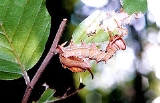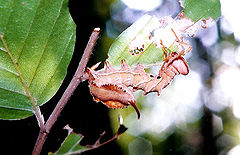
Lobster Moth
Encyclopedia
The Lobster Moth is a moth
from the family Notodontidae
. The moth has a wingspan ranging from 40 to 70 millimetres and varies in color from grey to green and brown.
 The moth lives in the whole Palearctic ecozone except the North of Africa. In England it is more frequent in the Southern counties.
The moth lives in the whole Palearctic ecozone except the North of Africa. In England it is more frequent in the Southern counties.
the caterpillar
feeds entirely on its own egg-shell and is unusual in that it mimics an ant
or small spider. This is due to the long thoracic legs "and caudal appendages which are ever nervously twisting about". If the larva
is disturbed during this period it wriggles about violently in the same manner as an injured ant. "The young caterpillars keep guard over their own egg-shell. They keep nervously moving around and about this, and if perchance another caterpillar should approach within touch of it, a vigorous attack is made to drive off the intruder." After the first skin change the larvae feed on the leaves of Oak
, Beech
, Birch
or Hazel
. During the following instars the caterpillar develops even more of an odd appearance with "a large head, (the) long thoracic legs, raised humps on the fourth to seventh segments and a greatly swollen anal segment that has the claspers modified into long thin structures" The general colour is reddish brown and if in its resting position provides perfect cryptic camouflage
. The larva
e can grow to a length of 70 mm and if disturbed by a potential predator can put on a menacing display with the thoracic
legs splayed out and the head arched back over the body. The moth pupates in a strong cocoon, "usually spun up between dead leaves".
The moths emerge the following year from May until July depending on conditions.
Moth
A moth is an insect closely related to the butterfly, both being of the order Lepidoptera. Moths form the majority of this order; there are thought to be 150,000 to 250,000 different species of moth , with thousands of species yet to be described...
from the family Notodontidae
Notodontidae
Notodontidae is a family of moths with approximately 3,500 known species. Moths of this family are found in all parts of the world, but they are most concentrated in tropical areas, especially in the New World...
. The moth has a wingspan ranging from 40 to 70 millimetres and varies in color from grey to green and brown.

Life history
In the first instarInstar
An instar is a developmental stage of arthropods, such as insects, between each molt , until sexual maturity is reached. Arthropods must shed the exoskeleton in order to grow or assume a new form. Differences between instars can often be seen in altered body proportions, colors, patterns, or...
the caterpillar
Caterpillar
Caterpillars are the larval form of members of the order Lepidoptera . They are mostly herbivorous in food habit, although some species are insectivorous. Caterpillars are voracious feeders and many of them are considered to be pests in agriculture...
feeds entirely on its own egg-shell and is unusual in that it mimics an ant
Ant
Ants are social insects of the family Formicidae and, along with the related wasps and bees, belong to the order Hymenoptera. Ants evolved from wasp-like ancestors in the mid-Cretaceous period between 110 and 130 million years ago and diversified after the rise of flowering plants. More than...
or small spider. This is due to the long thoracic legs "and caudal appendages which are ever nervously twisting about". If the larva
Larva
A larva is a distinct juvenile form many animals undergo before metamorphosis into adults. Animals with indirect development such as insects, amphibians, or cnidarians typically have a larval phase of their life cycle...
is disturbed during this period it wriggles about violently in the same manner as an injured ant. "The young caterpillars keep guard over their own egg-shell. They keep nervously moving around and about this, and if perchance another caterpillar should approach within touch of it, a vigorous attack is made to drive off the intruder." After the first skin change the larvae feed on the leaves of Oak
Oak
An oak is a tree or shrub in the genus Quercus , of which about 600 species exist. "Oak" may also appear in the names of species in related genera, notably Lithocarpus...
, Beech
Beech
Beech is a genus of ten species of deciduous trees in the family Fagaceae, native to temperate Europe, Asia and North America.-Habit:...
, Birch
Birch
Birch is a tree or shrub of the genus Betula , in the family Betulaceae, closely related to the beech/oak family, Fagaceae. The Betula genus contains 30–60 known taxa...
or Hazel
Hazel
The hazels are a genus of deciduous trees and large shrubs native to the temperate northern hemisphere. The genus is usually placed in the birch family Betulaceae, though some botanists split the hazels into a separate family Corylaceae.They have simple, rounded leaves with double-serrate margins...
. During the following instars the caterpillar develops even more of an odd appearance with "a large head, (the) long thoracic legs, raised humps on the fourth to seventh segments and a greatly swollen anal segment that has the claspers modified into long thin structures" The general colour is reddish brown and if in its resting position provides perfect cryptic camouflage
Camouflage
Camouflage is a method of concealment that allows an otherwise visible animal, military vehicle, or other object to remain unnoticed, by blending with its environment. Examples include a leopard's spotted coat, the battledress of a modern soldier and a leaf-mimic butterfly...
. The larva
Larva
A larva is a distinct juvenile form many animals undergo before metamorphosis into adults. Animals with indirect development such as insects, amphibians, or cnidarians typically have a larval phase of their life cycle...
e can grow to a length of 70 mm and if disturbed by a potential predator can put on a menacing display with the thoracic
Thorax (insect anatomy)
The thorax is the mid section of the insect body. It holds the head, legs, wings and abdomen. It is also called mesosoma in other arthropods....
legs splayed out and the head arched back over the body. The moth pupates in a strong cocoon, "usually spun up between dead leaves".
The moths emerge the following year from May until July depending on conditions.

